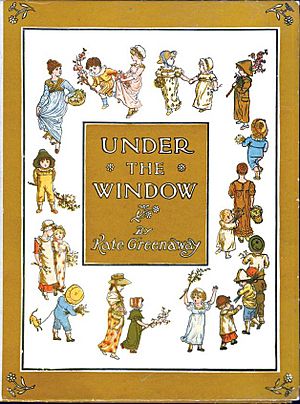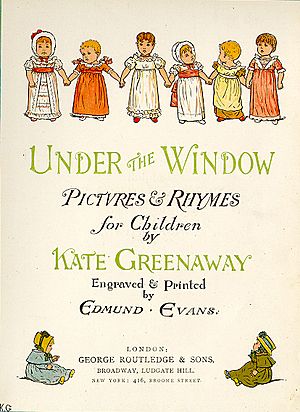Under the Window facts for kids

Cover
|
|
| Author | Kate Greenaway/Edmund Evans |
|---|---|
| Illustrator | Kate Greenaway |
| Cover artist | Kate Greenaway |
| Genre | Toy book |
| Publisher | George Routledge & Son |
|
Publication date
|
1879 |
| Pages | 64 |
Under the Window: Pictures & Rhymes for Children is a famous children's picture book from 1879. It was the very first book written and illustrated by Kate Greenaway. This book was a huge hit, selling over 100,000 copies! Its success helped Kate Greenaway become a well-known children's book artist and writer in the late 1800s. It also started a popular trend called the "Greenaway vogue", where her unique style became very fashionable.
Even though Kate Greenaway illustrated more than 150 books, Under the Window and Marigold Garden (published in 1885) were the only two books she both wrote and drew for. Under the Window is seen as one of the first "designer picture books." This means it was carefully planned, with the pictures and words working together perfectly. Because it was so popular, many other books tried to copy its style.
How the Book Was Made
In the late 1870s, Kate Greenaway was drawing pictures for greeting cards. She convinced her father, who worked in the printing business, to show her book idea, Under the Window, to a printer named Edmund Evans. Evans was very impressed. He said, "I was at once fascinated by the originality of the drawings and the ideas of the verse." He quickly bought the rights to publish them.
Evans believed Greenaway's drawings would be very popular. He encouraged the publisher Routledge to print the book. Evans later wrote about how successful it was: "I printed the first edition of 20,000 copies. Publishers made fun of me for risking such a large number of books. But the books sold out before I could print more! People even paid extra to get a copy. We kept reprinting until 70,000 copies were sold."
What's Inside the Book
Under the Window: Pictures and Rhymes for Children is filled with both new rhymes written by Greenaway and classic nursery rhymes.
In the book, Greenaway drew children wearing clothes inspired by old-fashioned styles from the early 1800s. People at the time loved this because the children's outfits looked sweetly old-fashioned. This style also fit in with the "Artistic Dress movement" of the era, which favored more natural and flowing clothing. Greenaway's books became so popular that the clothes her characters wore actually came back into fashion!
The book's style was also influenced by the Arts and Crafts movement. This movement focused on beautiful, handmade items. The book's pictures have a charming, old-time feel with soft, gentle colors. Each page has a border around the pictures, making them look like little scenes you are peeking into. The colors are mostly soft yellows and greens. Other popular things shown in the book include sunflowers, blue and white china, and Queen Anne Style architecture. You can also see the influence of Japanese woodblock prints. These prints often have clear outlines, flat, delicate colors, and lots of empty space.
The pictures are the main focus of the book, with the rhymes adding to the story. The images show scenes from the English countryside, children's imaginary worlds, and funny grown-up situations.
Books That Copied It
Just weeks after Under the Window came out, several other books tried to copy its style. This made Kate Greenaway very upset. The most famous copy was a children's book called Afternoon Tea: a book of new rhymes for children. It was made by John George Sowerby and Henry Hetherington Emmerson and published by a different company, Frederick Warne & Co. Greenaway felt it was a "blatant piracy," meaning it was a very obvious copy.
Edmund Evans, her printer, also shared her frustration. He wrote that many artists tried to copy her new style. Some even took parts of her drawings, like a head from one picture and a body from another. One artist even tried to sell Evans a book called Afternoon Tea. Evans refused to have anything to do with such a clear copy. He noted that the book was published by another company and was often sold as if it were a "Kate Greenaway Book."
Greenaway's friends thought Afternoon Tea was a rude copy and told her to take legal action. Her biographer, Rodney Engen, called Afternoon Tea a bad imitation of Greenaway's style. He pointed out "shocking alterations," like a boy secretly smoking a pipe and a dark graveyard, using colors Greenaway would never use. Another friend, Frederick Locker-Lampson, said the book was a "shameful imitation" that could make the public tired of her style and hurt her career.



